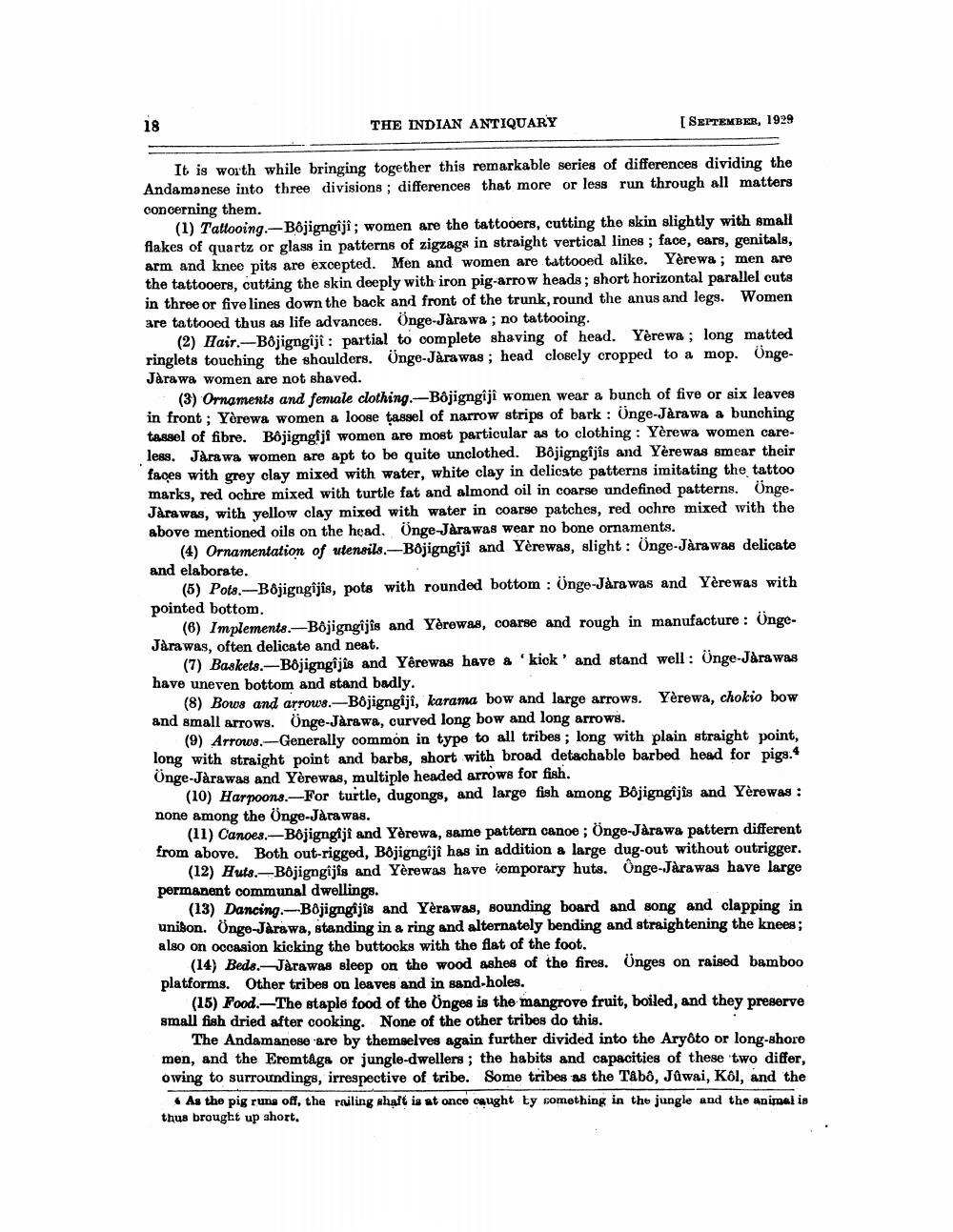________________
THE INDIAN ANTIQUARY
[ SEPTEMBER, 1929
It is worth while bringing together this remarkable series of differences dividing the Andamanese into three divisions ; differences that more or less run through all matters concerning them.
(1) Tattooing.-Bôjigngijî; women are the tattooers, cutting the skin slightly with small flakes of quartz or glass in patterns of zigzaga in straight vertical lines ; face, ears, genitals, arm and knee pits are excepted. Men and women are tattooed alike. Yèrewa; men are the tattooers, cutting the skin deeply with iron pig-arrow heads; short horizontal parallel cuts in three or five lines down the back and front of the trunk, round the anus and legs. Women are tattooed thus as life advances. Onge-Járawa ; no tattooing.
(2) Hair.-Bôjigngiji: partial to complete shaving of head. Yèrewa; long matted ringlets touching the shoulders. Onge-Járawas ; head closely cropped to a mop. OngeJarawa women are not shaved.
(3) Ornaments and female clothing.-Bôjigngijî women wear a bunch of five or six leaves in front ; Yèrewa women a loose tassel of narrow strips of bark : Önge-Járawa a bunching tassel of fibre. Bôjigngfji women are most particular as to clothing: Yèrewa women careless. Jarawa women are apt to be quite unclothed. Bôjigngijîs and Yèrewas smear their faqes with grey clay mixed with water, white clay in delicate patterns imitating the tattoo marks, red ochre mixed with turtle fat and almond oil in coarse undefined patterns. Önge. Jarawas, with yellow clay mixed with water in coarse patches, red ochre mixed with the above mentioned oils on the head. Önge-Jarawas wear no bone ornaments.
(4) Ornamentation of utensils.-Bojigngiji and Yèrewas, slight : Önge-Jara was delicate and elaborate.
(5) Pots.Bêjigngijis, pots with rounded bottom : Önge-Jara was and Yèrewas with pointed bottom.
(6) Implements.-Bôjigngijis and Yèrewes, coarse and rough in manufacture : ÖngeJarawas, often delicate and neat.
(7) Baskets.-Bôjigngijis and Yêrewas have & kick' and stand well : Unge-Jara was have uneven bottom and stand badly.
(8) Bows and arrows.-Bôjigngiji, karama bow and large arrows. Yèrewa, chokio bow and small arrows. Önge-JÀrawa, curved long bow and long arrows.
(9) Arrows. Generally common in type to all tribes; long with plain straight point, long with straight point and barbs, short with broad detachable barbed head for pigs. Onge-Járawas and Yèrewas, multiple headed arrows for fish.
(10) Harpoons. For turtle, dugongs, and large fish among Bôjigngijis and Yèrewas : none among the Önge-Jarawas.
(11) Canoes.Bojigngiji and Yèrewa, same pattern canoe ; Onge-Járawa pattern different from above. Both out-rigged, Bðjigngiji has in addition a large dug-out without outrigger.
(12) Huts. Böjigngijis and Yèrewas have temporary huts. Onge-Jarawas have large permanent communal dwellings.
(13) Dancing.-Bôjigngijis and Yerawas, sounding board and song and clapping in unison. Onge-Járawa, standing in a ring and alternately bending and straightening the knees; also on occasion kicking the buttocks with the flat of the foot.
(14) Bed8.- Jarawas sleep on the wood ashes of the fires. Unges on raised bamboo platforms. Other tribes on leaves and in sand-holes.
(15) Food.-The staple food of the Onges is the mangrove fruit, boiled, and they preserve small fish dried after cooking. None of the other tribes do this.
The Andamanese are by themselves again further divided into the Aryto or long-shore men, and the Eremtaga or jungle-dwellers; the habits and capacities of these two differ, owing to surroundings, irrespective of tribe. Some tribes as the Tabo, Jûwai, Kol, and the
As the pig runs off, the railing shalt is at once caught ty something in the jungle and the animal is thus brought up short,




